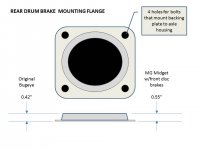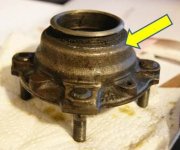DanLewis
Jedi Trainee
Offline
When I converted the front drum brakes to disc brakes, I dutifully changed the master cylinder and rear brakes to the later style from an MG Midget as recommended (see here). After reassembling the rear brakes, I found that the hubs were rubbing on the backing plates. At the time I temporarily solved the problem by adding a washer acting as a spacer between the axle and the hub, thus spacing the hubs outward a fraction of an inch.
Today I disassembled the rear brakes and took some measurements. It turns out that the original Bugeye backing plates are different from those fitted on later model MG Midgets. First, the outside diameter of the Midget's plates is greater, but that doesn't create any problems. The problem is the thickness of the flange on the backing plate that is used to mount it to the axle housing. I've attached a drawing to illustrate the problem. If anyone has changed their rear brake backing plates to the later model MG Midgets and made it work, please let me know what you did.
For example, does anyone know if the rear hubs on the later model Midget is different?
Thanks!
Dan

Today I disassembled the rear brakes and took some measurements. It turns out that the original Bugeye backing plates are different from those fitted on later model MG Midgets. First, the outside diameter of the Midget's plates is greater, but that doesn't create any problems. The problem is the thickness of the flange on the backing plate that is used to mount it to the axle housing. I've attached a drawing to illustrate the problem. If anyone has changed their rear brake backing plates to the later model MG Midgets and made it work, please let me know what you did.
For example, does anyone know if the rear hubs on the later model Midget is different?
Thanks!
Dan


 Hi Guest!
Hi Guest!

 smilie in place of the real @
smilie in place of the real @
 Pretty Please - add it to our Events forum(s) and add to the calendar! >>
Pretty Please - add it to our Events forum(s) and add to the calendar! >> 
